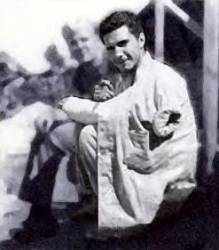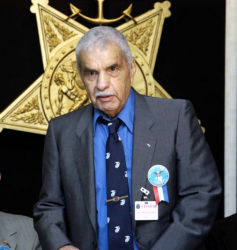
 |
|
|
||
|
Guy Louis Gabaldon |
||||
|
Engagements: • World War II (1941 - 1945) |
||||
| Biography: | ||||
|
Guy Louis Gabaldon Guy Louis Gabaldon was born on 22 March 1926 in Los Angeles, CA, one of seven children in a Mexican-American family. He was raised in East Los Angeles where, as a ten year old, he would earn a living by shining shoes on Skid Row. Gabaldon who was a member of a multiethnic gang referred to as the "Moe gang," moved out of his house at the age of 12 and moved in with the Nakanos, a family of Japanese-American heritage whom he considered his extended family. He attended language school every day with their children and learned to speak Japanese. He also learned about their customs and culture. World War II At the outbreak of World War II his "adopted" family, the Nakanos, were sent to a relocation camp in Arizona. Gabaldon went to Alaska to work in a cannery. On 22 March 1943, Gabaldon's 17th birthday, he joined the U.S. Marine Corps. After receiving his basic training at Camp Pendleton, he was assigned to Headquarters & Service Company, 2nd Marine Regiment, 2nd Marine Division. The Pied Piper of Saipan The U.S. considered the possibility of a full scale invasion of the Japanese mainland but decided that such a feat would be costly with an estimated one million American casualties. The capture of Saipan was considered essential for the establishment of airfields which would accommodate the B-29 Superfortress bombers to be used for the planned invasion. On 15 June 1944, an armada of 535 ships carrying 127,570 U. S. military personnel, which included Marines from the 2nd and 4th Divisions, began the invasion of Saipan. Japanese soldiers seldom surrendered during World War II and, as the invasion went badly for the Japanese, they were ordered by their superiors on Saipan to kill seven U.S. Marine and Army troops for every man they lost, or commit suicide. Gabaldon began bringing in prisoners the very first day that he arrived on Saipan. According to Gabaldon: "The first night I was on Saipan, I went out on my own," said Gabaldon, "I always worked on my own, and brought back two prisoners using my backstreet Japanese." He was reprimanded by his superior officers and threatened with a court-martial for leaving his post. However, the next night he went out and repeated once more his actions. He carefully approached a cave, shot the guards outside, moved off to one side of the cave, and yelled in Japanese, "You're surrounded and have no choice but to surrender. Come out, and you will not be killed! I assure you will be well-treated. We do not want to kill you!" The next morning he returned with 50 Japanese prisoners. As a result Gabaldon was permitted by his commanding officer to act as a "lone wolf" operator. This was the situation when, on 7 July 1944, after spending a night near Saipan's northern cliffs, Gabaldon heard and listened to thousands of Japanese troops and civilians preparing for a large "banzai charge." The attack was unsuccessful and the surviving Japanese returned to their positions. The next day, Gabaldon captured two guards and convinced one of them to return to the cave with an offering of surrender. Shortly after, a Japanese officer showed up and, after speaking to Gabaldon, accepted the conditions of surrender. Over eight hundred soldiers and civilians surrendered to Gabaldon and were turned over to the U.S. military authorities. For his exploits, Gabaldon became known as the "Pied Piper of Saipan." Gabaldon continued to capture more Japanese soldiers until he was wounded in a machine gun ambush. He was credited with the capture of 1,500 enemy personnel and was recommended for the Medal of Honor by his Commanding Officer, Capt. John Schwabe, on the justification that he singlehandedly captured more than ten times the number of prisoners taken by Sgt. Alvin C. York in World War I. However, Gabaldon was awarded a Silver Star instead. Gabaldon received an Honorable Discharge from the Marine Corps as a result of his combat wounds. Medals and Awards Navy Cross Honors In September 2004, he was among the Hispanics honored by the Pentagon during a ceremony honoring Hispanic-American World War II veterans. On 7 July 2006, Gabaldon was honored by the Mayor of Los Angeles, Antonio Villaraigosa and the entire Los Angeles City Council. The Mayor and the City Council prepared a resolution which was sent to the White House requesting the Medal of Honor for Gabaldon. That same year the World War II Veteran's Committee in Washington, DC, a prominent organization that showcases the veterans of World War II and their history, featured Gabaldon on the cover of their quarterly magazine. Gabaldon was also honored by the National Council of La Raza, a national organization and a leading Latino civil rights advocate at their annual conference that July. Various organizations have requested the Medal of Honor for Gabaldon, but their requests have been rejected. After lobbying by the Hispanic community, the case is currently under review by the Department of Defense to determine whether Gabaldon's Navy Cross Medal should be upgraded to the original recommendation, the Medal of Honor. Civilian Life After returning to civilian life, he moved to Mexico and ventured into various businesses such as a furniture store, fishing, and the import-export of Mexican goods. Gabaldon, whose first marriage to June Gabaldon ended in divorce, met the person who was to became his second wife, Ohana Suzuki while working in Mexico. Gabaldon's World War II exploits became public when, in 1957, he was the invited guest of This is Your Life, a popular television program hosted by Ralph Edwards and aired by NBC in the 1950s. The show presented the life stories of entertainment personalities and "ordinary" people who had contributed in some way to society. The fact that he captured at least 1,500 Japanese prisoners was verified on the national program by Marines Corps Intelligence Officers Colonel Walter Layer, Colonel John Schwabe, Major James High and several enlisted men from military intelligence. Hollywood producers became interested in Gabaldon's story and, in 1960, released the film Hell to Eternity where his actions on Saipan were memorialized. He was portrayed by Jeffrey Hunter as an adult and by Richard Eyer as a boy. Gabaldon served as an adviser in the filming of the movie. On 23 November 1960, after his exploits became widely known through the television program and the movie, the U.S. Government upgraded his Silver Star Medal to a Navy Cross Medal, which is the Marine Corps second highest military award for valor; second only to the Medal of Honor. Gabaldon ran unsuccessfully for the U.S. Congress in California in 1964. In 1970, he moved to Saipan with his wife and established a seafood business. There he authored and self-published a book; Saipan: Suicide Island, also re-printed as America Betrayed. He lived in Saipan for 20 years. Gabaldon returned to California in 1995 and then moved to Old Town, FL, in 2003. Death and Burial Private First Class Guy Louis Gabaldon died on 31 August 2006 in Old Town, FL, of heart disease. He is buried at Arlington National Cemetery in Arlington, VA. Gabaldon is survived by his wife, Ohana; his sons Guy Jr., Ray, Tony, Yoshio, Jeffrey and Russell; and his daughters Aiko, Hanako and Manya. |
||||
| Honoree ID: 2526 | Created by: MHOH | |||
Ribbons
Medals
Badges
Honoree Photos
 |  |  |
 |  |
 |


